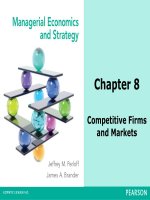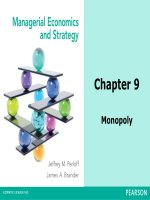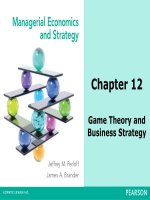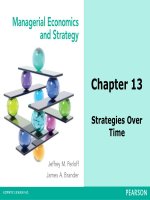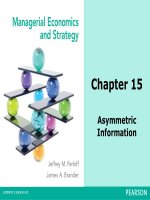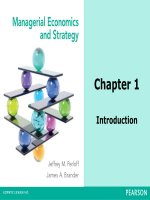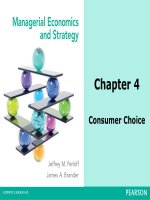Managerial economics 3rd by froeb ch17
Bạn đang xem bản rút gọn của tài liệu. Xem và tải ngay bản đầy đủ của tài liệu tại đây (2.48 MB, 24 trang )
11
Chapter 17:
Making
Decisions with
Uncertainty
1
Copyright ©2014 Cengage Learning. All Rights Reserved. May not be scanned, copied or duplicated, or posted to a publicly accessible website, in whole or in part.
Summary of main points
•
•
•
When you’re uncertain about the costs or benefits of a decision, replace numbers with
random variables and compute expected costs and benefits.
Uncertainty in pricing: When customers have unknown values, you face a familiar
trade-off: Price high and sell only to high-value customers, or price low and sell to all
customers.
If you can identify high-value and low-value customers, you can price discriminate and
avoid the trade-off. To avoid being discriminated against, high-value customers will try
to mimic the behavior and appearance of low-value customers.
Copyright ©2014 Cengage Learning. All Rights Reserved. May not be scanned, copied or duplicated, or posted to a publicly accessible website, in whole or in part.
Summary of main points
(cont.)
•
•
Difference-in-difference estimators are a good way to gather information about
the benefits and costs of a decision. The first difference is before versus after
the decision or event. The second difference is the difference between a
control and an experimental group.
If you are facing a decision in which one of your alternatives would work well
in one state of the world, and you are uncertain about which state of the world
you are in, think about how to minimize expected error costs.
Copyright ©2014 Cengage Learning. All Rights Reserved. May not be scanned, copied or duplicated, or posted to a publicly accessible website, in whole or in part.
•
•
Introductory anecdote:
TeleSwitch
A large telecom supplier, TeleSwitch, sold its product only through distributors.
In 2000, their largest clients wanted to deal directly with TeleSwitch – and avoid the
middle man distributor. TeleSwitch was unsure what to do.
• They might lose large customers if they didn’t switch.
• But, they might lose distributors (and their small
customers) if they did.
•
•
•
There is a lower probability of losing dealers (because
they would have to incur costs to change suppliers)
But this would have a much larger impact on profit.
How should we analyze decisions like this??
Copyright ©2014 Cengage Learning. All Rights Reserved. May not be scanned, copied or duplicated, or posted to a publicly accessible website, in whole or in part.
Introduction: Uncertainty
•
•
•
This problem illustrates the type of uncertainty that exist in most business decisions.
This chapter looks at ways to help deal with uncertainty and arrive at decisions that
will best profit your firm.
By modeling uncertainty, you can:
• Learn to make better decisions
• Identify the source(s) of risk in a
decisions
• Compute the value of collecting more
information.
Copyright ©2014 Cengage Learning. All Rights Reserved. May not be scanned, copied or duplicated, or posted to a publicly accessible website, in whole or in part.
Modeling Uncertainty
•
•
•
To model uncertainty we use random variables to compute the expected costs and
benefits of a decision.
Definition: a random variable is simply a way of representing numerical outcomes
that occur with different probabilities.
To represent values that are uncertain,
• list the possible values the variable could take,
• assign a probability to each value, and
• compute the expected values (average outcomes)
by calculating a weighted average using the
probabilities as the weights.
Copyright ©2014 Cengage Learning. All Rights Reserved. May not be scanned, copied or duplicated, or posted to a publicly accessible website, in whole or in part.
Random variables
•
Definition: a binomial random variable, X, can have two values, x1 or x2, with
probabilities, p and 1-p. The expected value (mean) for a binomial random variable
is:
E[X]=p*x1+(1-p)x2
•
Definition: a trinomial random variable, X, can have three values, x1,x2, or x3,
with probabilities p1, p2, and 1-p1–p2. The mean for a trinomial random variable
is:
E[X]= p1*x1+ p2*x2+(1- p1-p2) x3
Copyright ©2014 Cengage Learning. All Rights Reserved. May not be scanned, copied or duplicated, or posted to a publicly accessible website, in whole or in part.
How to model uncertainty
•
“Wheel of Cash” example:
• The carnival game wheel is divided like a pie
into thirds, with values of $100, $75, and $5
painted on each of the slices
• The cost to play is $50.00
• Should you play the game?
•
•
•
Three possible outcomes: $100, $75, and $5
with equal probability of occurring (assuming the
wheel is “fair”)
Expected value of playing the game is
1/3 ($100) + 1/3 ($75) + 1/3 ($5) = $60
But, if the wheel is biased toward the $5
outcome, the expected value is
1/6 ($100) + 1/6 ($75) + 2/3 ($5) = $32.50
Copyright ©2014 Cengage Learning. All Rights Reserved. May not be scanned, copied or duplicated, or posted to a publicly accessible website, in whole or in part.
TeleSwitch’s Decision Tree
• The probability of losing customers is 0.6
• The probability of losing distributors is 0.2
Copyright ©2014 Cengage Learning. All Rights Reserved. May not be scanned, copied or duplicated, or posted to a publicly accessible website, in whole or in part.
Entry Decision with
Uncertainty
•
The probability of retaliation (no accommodation) to an entry decision (as modeled in ch 15) is
0.5
Copyright ©2014 Cengage Learning. All Rights Reserved. May not be scanned, copied or duplicated, or posted to a publicly accessible website, in whole or in part.
Dealing with uncertainty
• Discussion: How do you respond to an invitation
from a friend to invest in a real estate venture
that depends on uncertain future demand and
interest rates?
• Calculate the potential gains and loses based
on different combinations of high and low
interest rates and high and low demand
• Whoever proposed the venture probably
presented the best case scenario (low interest
rates and high demand) – and that is the only
combination (of four possible outcomes)
under which you will do well.
• Either don’t invest or find a way that aligns
your friend’s incentives with your own, i.e., he
gets a payoff only if the venture does well.
Copyright ©2014 Cengage Learning. All Rights Reserved. May not be scanned, copied or duplicated, or posted to a publicly accessible website, in whole or in part.
Uncertainty in Pricing
•
•
Uncertainty in pricing arises when the demand for a product is unknown.
To model this uncertainty, classify the number and type of potential customers. For
example:
• High-value consumers willing to pay $8
• Low-value consumers willing to pay $5
• Suppose there are equal numbers of each
•
consumer group
Discussion: If MC= $3, what is optimal price?
• By pricing high, you would earn $5 per sale each
time a high-value costumer shops – or %50 of the
time
• By pricing low, you would earn $2 per sale but would
be able to sell to both high- and low-value costumers
– 100% of the time.
Copyright ©2014 Cengage Learning. All Rights Reserved. May not be scanned, copied or duplicated, or posted to a publicly accessible website, in whole or in part.
Uncertainty in Pricing (cont.)
•
Answer: Price High
Copyright ©2014 Cengage Learning. All Rights Reserved. May not be scanned, copied or duplicated, or posted to a publicly accessible website, in whole or in part.
Price Discrimination
Opportunity
•
If you can identify the two types of customers, set different prices to each
group, and prevent arbitrage between them, then you can price discriminate.
• Price of $8 to the high-value customers
• Price of $5 to the low-value customers.
•
•
Discussion: When buying a new car, sales people discriminate between highand low-value customers. How do they do this?
Discussion: What can you do to defeat this?
Copyright ©2014 Cengage Learning. All Rights Reserved. May not be scanned, copied or duplicated, or posted to a publicly accessible website, in whole or in part.
Natural experiments
•
•
To gather information about the benefits and costs of a decision you can run natural
experiments.
Natural experiment example: A national restaurant chain
• A regional manager wanted to test the profitability
of a special holiday menu
• To do this, the menu was introduced in half the
restaurants in her region.
• In comparing sales between the new menu locations
and the regular menu locations (the control group)
the manager hoped to isolate the effect of the
holiday menu on profit.
Copyright ©2014 Cengage Learning. All Rights Reserved. May not be scanned, copied or duplicated, or posted to a publicly accessible website, in whole or in part.
Natural experiments (cont.)
• This is a difference-in-difference estimator. The first
difference is before vs. after the introduction of the
menu; the second difference is the experimental vs.
control groups
• Difference-in-difference controls for unobserved factors
that can influence changes
•
The manager found that sales jumped during the holiday season – but the increase was seen
both in the control and experimental groups—both increased by the same amount.
• The manager concluded that the holiday menu’s popularity
came at the expense of the regular menu. So the holiday
menu only cannibalized the regular menu’s demand and
didn’t attract new customers to the restaurant.
Copyright ©2014 Cengage Learning. All Rights Reserved. May not be scanned, copied or duplicated, or posted to a publicly accessible website, in whole or in part.
Natural experiments (cont.)
•
•
Natural experiments can be useful in many different contexts.
When the FTC looked back at a 1998 gasoline merger in Louisville, they used their
own version of a difference-in-difference estimator.
• Three control cities (Chicago, Houston, and
Arlington) were used to control for demand and
supply shocks that could affect price.
• The first difference was before vs. after the
merger; the second difference was Louisville
prices vs. prices in control cities– this allowed the
FTC to isolate the effects of the merger and
determine its effect
Copyright ©2014 Cengage Learning. All Rights Reserved. May not be scanned, copied or duplicated, or posted to a publicly accessible website, in whole or in part.
1998 LouisGasoline Merger
Copyright ©2014 Cengage Learning. All Rights Reserved. May not be scanned, copied or duplicated, or posted to a publicly accessible website, in whole or in part.
Minimizing expected error
costs
•
•
Sometimes, when faced with a decision, instead of focusing on maximizing expected
profits (benefits minus costs) it can be useful to think about minimizing expected “error
costs.”
This approach is helpful when one alternative would work well only under certain
conditions, and you are uncertain about whether the conditions hold.
• For example, “should we impose a carbon tax?”
•
•
If global warming is caused by human activity then a
carbon tax will help reduce it.
But if global warming is not caused by human activity,
then a carbon tax would only reduce economic activity
and would not cool the Earth.
Copyright ©2014 Cengage Learning. All Rights Reserved. May not be scanned, copied or duplicated, or posted to a publicly accessible website, in whole or in part.
Error costs (cont.)
•
The two global warming alternatives can be modeled by:
Carbon Tax
No Tax
GW is caused by human
activity (p)
0
(p) x (error cost
II)
GW is not caused by human
activity (1-p)
(1-p) x (error cost
I)
0
• Type I error is the failure to tax when global warming (GW)
is caused by human activity.
• The Type II error is the implementation of a carbon tax when
global warming (GW) is not caused by human activity.
• The optimal decision is the one with the smaller expected
error costs, i.e. Tax if (1-p)*Cost(Type I) < p*Cost(Type II)
• This type of analysis is especially useful for balancing the
risks associated with pricing errors (over- v. under-), e.g., for
airlines, hotels, cruise ships; as well as production errors
(over v. under)
Copyright ©2014 Cengage Learning. All Rights Reserved. May not be scanned, copied or duplicated, or posted to a publicly accessible website, in whole or in part.
Risk versus uncertainty
•
Risk is how we characterize uncertainty about values that are variable.
• Risk is modeled using random variables.
•
Uncertainty is uncertainty about the about the distribution of the random variables.
• E.g., which probabilities should be assigned to the
various values the random variables can take?
•
•
This difference is critical in financial markets. Risk can be predicted, priced and
traded – people are comfortable with risk. Dealing with uncertainty is much more
difficult.
Mistaking risk for uncertainty can be a costly mistake.
Copyright ©2014 Cengage Learning. All Rights Reserved. May not be scanned, copied or duplicated, or posted to a publicly accessible website, in whole or in part.
IndyMac: Risk vs. Uncertainty
•
•
• Investors confused the absence of volatility with the
absence of risk
Risk never went away, investors were just
ignoring it
Black Swans & fat tails
• I have nothing against
economists: you should
let them entertain each
others with their
theories and elegant
mathematics, [But]…do
not give any of them
risk-management
responsibilities.
--Nassim Nicholas Taleb
Vanderbilt University
Copyright ©2014 Cengage Learning. All Rights Reserved. May not be scanned, copied or duplicated, or posted to a publicly accessible website, in whole or in part.
22
Dealing with uncertainty
•
Uncertainty is unavoidable. So to cope with uncertainty in decision making, gather
more or better information.
• Best Buy has used dispersed sets of non-experts
to predict future variables, such as a holiday sales
rate.
• Google uses internal prediction markets to
generate demand and usage forecasting.
•
The US Marines advise:
• Because we can never eliminate uncertainty, we
must learn to fight effectively despite it. We can
do this by developing simple, flexible plans;
planning for likely contingencies; developing
standing operating procedures; and fostering
initiative among subordinates.
Copyright ©2014 Cengage Learning. All Rights Reserved. May not be scanned, copied or duplicated, or posted to a publicly accessible website, in whole or in part.
Alternate Intro Anecdote:
Risk versus uncertainty
•
Part of the housing crisis can be attributed to an error in translating uncertainty to risk through
a mathematical formula created by David Li.
• The formula was designed to measure the correlation
between returns of various assets that made up
collateralized debt obligations (CDOs).
• But there was uncertainty about how one asset’s failure
would related to that of another asset. There was also a
lack of historical data about relationships among the
underlying assets.
•
Li’s solution was to use past credit default swap (CDS) prices as an indication of correlation
returns (clever but imperfect).
• CDS data came from a time when housing prices were on
the rise, and the correlation changed during a period of
decreasing prices.
• Nearly everyone was using this formula, and… we’ve
seen how it all turned out
Copyright ©2014 Cengage Learning. All Rights Reserved. May not be scanned, copied or duplicated, or posted to a publicly accessible website, in whole or in part.
